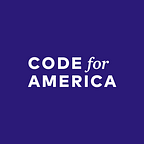Summit 2019: Service Design in Local Government with Michelle Thong
Code for America Summit is just around the corner, and in the coming weeks we’ll be giving you a preview of our lineup of inspiring speakers. These are leaders in tech and government who not only share our vision for a radically improved future for government services, but show what works and imagine what’s possible. Want to hear more? It’s not too late to get your tickets!
As Digital Services Lead for the City of San Jose, Michelle is bringing user-centered, iterative approaches to a local government that serves 1 million residents and 60,000 businesses. Michelle found her way to the civic tech movement through the Code for America Brigade Network, as co-founder of Code for San Jose. At this year’s Code for America Summit, Michelle will give a keynote talk about why connecting to a community of fellow practitioners is essential to our journeys as leaders in our own organizations.
The theme of Summit 2019 is “Designing better government” — what does that look like to you?
To me, the verb “design” signifies intentionality, which is exactly what’s needed to improve government services. A lot of bad experiences with government happen by accident — not because we want our services to be hard to use, but because we aren’t even looking at what the experience is like for the people we’re serving. As a result, our services mirror the organizational structure and rules of government.
A design-led approach gives us the opportunity to be more explicit and thoughtful about who the services are for, what outcomes we’re trying to achieve, and how the end-to-end experience of a service influences those outcomes.
How does designing better government relate to your work?
In the City of San Jose, our vision is that government services are easy to find, easy to use and accessible to everyone. We already think of ourselves as a service delivery organization, but to realize this vision, we need to start thinking of ourselves as service designers as well.
One key step we took this year is to hire designers. We got our feet wet with Code for America’s 2018 Community Fellowship program, engaging two local designers, Julie Kim and Nira Datta, on a important user research question: how to make our 311 reporting app more inclusive for lower-income and non-English-speaking residents. By the time their fellowship ended, it was clear that we needed their UX skills to help us achieve other major objectives for the 311 app: building trust with residents and improving service delivery. Julie and Nira both continue working for the City in term-limited roles. Their skills have been essential in enabling us to conduct user research, prototype new designs, improve content, and test usability of top requested services on the 311 app as well as the City website.
Training existing City staff is an equally important part of our strategy in bringing user-centered design to government. We’ll never move the needle if our mindset is that design only gets done by a handful of specialists, when our reality is an organization of over 6,300 employees who deliver hundreds of distinct services. Last fall we piloted a “Digital Services Academy” that introduced over 20 City staff to writing user-centered website content for 10 of our City’s top requested services. The best part was teaching our colleagues how to conduct guerrilla usability testing on the street and witnessing their epiphanies when observing real users.
What are the biggest challenges that our movement is facing today?
I think many of us are looking for better ways of connecting and collaborating across organizations when we’re solving similar problems, especially at the local government level. On a weekly basis, I find myself wondering how other cities have handled a specific challenge that I’m facing, whether it’s improving the process for handling 311 requests, designing content for a multilingual population, or writing web governance standards for a highly decentralized organization. Being on Twitter gives me a sense of who is working on interesting things, but what I really need are nitty gritty details like org charts, budgets and the stories behind the press releases. Hannah Schank and Sara Hudson do an excellent job of articulating the need for more “connective tissue across the field” in their report on What Government Innovation Looks Like.
What are you excited for about Summit this year?
In 2019, I’m celebrating five years in the City of San Jose and five years of Code for San Jose, so this Summit is a special opportunity to reflect on how far my city, and the movement overall, have come over the past five years. Summit is also the perfect place to get the pulse of where the civic tech movement is today, by seeing what surfaces as key themes from all of the inspiring people who’ll be contributing to the event.
It’s up to us to design better government! Join members from local, state, and federal governments, technologists, and entrepreneurs and walk away feeling energized, with the right tools in your pocket to help improve government in the digital age. Join us on May 29–31 in Oakland, CA at the Oakland Marriott City Center.
